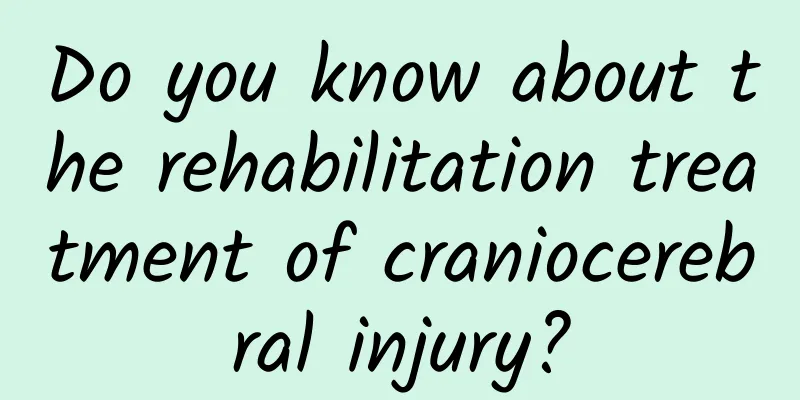Do you know about the rehabilitation treatment of craniocerebral injury?

|
Craniocerebral injury is an injury caused by external force to the head due to violence or other reasons. Craniocerebral injury is very common in clinical practice, usually referring to damage to the brain caused by external forces such as impact, blow, explosion, etc. Do you know about rehabilitation treatment after craniocerebral injury?
1. Daily care of craniocerebral injury Rehabilitation treatment for craniocerebral injury is a process that requires long-term persistence, but as long as it is carried out reasonably, it can effectively alleviate the symptoms of patients with craniocerebral injury. 1. Patients with concussion can use a head strap or neck brace to fix their heads, and use a soft pillow or other objects to cushion the patient's head to prevent the concussion from getting worse due to head movement. Immobilize the head and neck to avoid compressing the blood vessels, nerves, muscles and other tissues in the head and neck. 2. Keep the patient in a comfortable position. If conditions permit, the patient should be placed in a head-high, foot-low position. When in a supine position, the head of the bed should be raised 30 degrees and the neck should be in an upright position, which is conducive to venous return and relieves symptoms of intracranial hypertension. When in a side-lying position, avoid placing a large pillow behind the head or raising the shoulders on both sides in a side-lying position to prevent the neck from twisting. If conditions permit, the patient should be placed in a prone position intermittently (8-12 hours a day, which is conducive to airway drainage); 3. Patients should avoid strenuous exercise after head and neck injuries; physical therapy or massage can be performed to relieve pain and muscle spasms. 4. For patients in the recovery or sequelae stage of brain trauma, in addition to conventional treatment, exercise therapy can be combined to prevent the occurrence of complications, such as preventing and improving spastic paralysis through active or passive limb movements. 5. For patients with acute craniocerebral injury, the airway should be kept open; those with breathing difficulties should actively receive oxygen. In addition, appropriate sedatives can be given to reduce fear; for those who are unconscious, appropriate amounts of sedatives can be given to stabilize the patient's mood. 6. The patient's family and caregivers should closely observe changes in the patient's condition to prevent it from worsening.
2. Psychotherapy Patients with craniocerebral injury are prone to anxiety, depression and other negative emotions due to the blow, and due to their own illness and poor physical fitness, they are prone to fear and despair. 1. Provide patient guidance: Due to the trauma suffered by patients, they often have negative emotions such as fear and tension. In addition, due to the physical and psychological double blow brought by craniocerebral injury, patients develop a negative psychological state. 2. Give support and encouragement: During the rehabilitation process of patients with craniocerebral injury, we should focus on encouraging and supporting them. In daily life, we should communicate with patients more often, understand their true thoughts, and give them encouragement and support. At the same time, we should also pay attention to observe the psychological and emotional changes of patients and help them overcome psychological barriers. 3. Provide humanistic care: In daily life, we should pay attention to humanistic care for patients. We should pay more attention to and help patients, and always pay attention to their physical and mental conditions. At the same time, we should also pay attention to providing them with a comfortable and quiet resting environment. During the rehabilitation treatment process, we should focus on encouraging and supporting patients to help them overcome negative emotions and psychological barriers. 3. Exercise therapy 1. Daily living activities training: The main training content of patients in daily living activities is the recovery of self-care ability, which mainly includes getting up, dressing, going to the toilet, washing, eating, personal hygiene, etc. 2. Daily living ability training: In daily living activity training, attention should be paid to the patient's early exercise, helping them to develop good living habits and maintain an optimistic and cheerful mood. In daily life, patients should be encouraged to complete things within their ability and help them overcome psychological barriers. In addition, patients can also relieve anxiety and depression by listening to music, watching TV, etc. 3. Vocational skills training: Vocational skills training mainly includes personal cleaning, organizing items, work, going out and safety. Patients should choose the training content that suits them according to their actual situation. 4. Social skills training: In social skills training, we should focus on the recovery of patients’ communication skills, language expression skills and social skills. Through social skills training, we can improve patients’ ability to take care of themselves and enhance their confidence in communicating with others.
4. Speech Training During the rehabilitation treatment of patients with craniocerebral injury, the first thing to do is to train the patient's speech function. Specifically, it can start from the following aspects. 1. Voice training: First, we need to teach patients how to pronounce words and help them learn how to make simple sounds, such as "ah", "eh", etc. Secondly, we can help patients practice imitating sounds, such as: Who is dad's dad? Who is mom's mom? etc. 2. Language expression training: Patients need to communicate with others more in daily life, and can communicate with others through text, pictures, etc. In addition, they should communicate with others more in daily life, such as chatting with family and friends, watching TV, reading newspapers, etc. 3. Communication skills training: Patients with craniocerebral injury have reduced physical activity due to long-term bed rest, so their language expression ability will also be affected to a certain extent. Therefore, it is necessary to teach patients how to communicate with others and train their communication skills.
5. Daily living activities training Daily living activities training refers to training patients to be able to take care of their daily lives, maintain and improve their body functions, and improve their quality of life. For patients with craniocerebral injury, daily living activities training mainly includes the following aspects: 1. Turnover training is mainly aimed at bedridden patients, helping them to move from supine position to sitting position, then to standing, and then to walking. 2. Seat training is mainly for patients who are already able to sit independently, to help them practice sitting. Specifically, it includes crossing legs, stretching legs forward, stretching legs backward, bending forward, bending backward, stretching forward, etc. Specifically, it includes standing on one foot, standing on both feet alternately, etc. Specifically, it includes walking simulation training, walking on the spot, and walking fast on flat ground, etc. 6. Swallowing function training Swallowing function rehabilitation training is generally suitable for patients in the recovery period after oral and neck surgery, as well as patients with craniocerebral injury, cerebral infarction, eating disorders and other diseases. By practicing swallowing movements in a standardized manner, the purpose of functional recovery and normal life can be achieved. It can be divided into in-hospital swallowing function rehabilitation training and home swallowing function rehabilitation training. 1. In-hospital swallowing function rehabilitation training 1. Cold stimulation method: Professional rehabilitation personnel can use frozen cotton swabs to gently stimulate the patient's pharynx. The cold can stimulate the patient to secrete saliva, thus promoting swallowing movements. 2. Massage the soft palate: Professional rehabilitation personnel use their thumbs to gently massage from the back edge of the hard palate to the uvula, and be careful not to massage the affected area. Long-term massage stimulation is helpful for the recovery of swallowing function; 3. Direct training on eating: Under the care of professional rehabilitation personnel, guide the patient to try the head-down swallowing method, and swallow with the neck bent as far forward as possible. This is a relatively good choice for patients with delayed initiation of pharyngeal swallowing, insufficient retraction of the tongue root, and insufficient closure of the airway entrance. 2. Home swallowing function rehabilitation training 1. Lip exercises: clench your teeth and say "yeah" or "wool", hold for 5 seconds, do it 5 times a day, and you can also do blowing exercises, such as blowing air, blowing pinwheels, blowing soap bubbles, blowing whistles, etc. 2. Mandibular, facial and cheek exercises: Open your mouth as wide as possible, move your mandible to the left and right or chew in an exaggerated manner, then close your lips and puff up your cheeks, and then quickly transfer air to the left and right cheeks, hold for 5 seconds each, and repeat 5-10 times; 3. Tongue training: stick the tongue out of the mouth, hold it for 5 seconds and then retract it. Do tongue rolling exercise, open the mouth, lift the tip of the tongue to the back of the front teeth and stick it out, lift the tip of the tongue to the back of the front teeth and stick it to the hard palate and roll it back. Finally, do resistance training, stick out the tongue and press the tongue tip with the tongue depressor and the resistance of the tongue tip, hold it for 5 seconds respectively, and repeat 5-10 times. 7. Acupuncture therapy Acupuncture therapy is a method of treating diseases by stimulating acupuncture points. In acupuncture therapy, it can be divided into filiform needle therapy, electroacupuncture therapy, moxibustion, and fire needle therapy. Among them, filiform needle therapy mainly achieves the purpose of treating diseases by stimulating acupuncture points. In addition, acupuncture therapy can also be used for auxiliary treatment after craniocerebral injury. For example, electroacupuncture therapy can be chosen to treat patients, or moxibustion therapy can be chosen to treat patients. With the continuous development of medical technology, there are more and more patients with craniocerebral injury, so attention should be paid to rehabilitation treatment when treating craniocerebral injury. Patients with craniocerebral injury need to seek medical treatment in time and receive targeted treatment. In life, attention should be paid to a reasonable diet, moderate exercise and adequate sleep to help patients improve their physical fitness and enhance their resistance.
8. Hyperbaric oxygen therapy Hyperbaric oxygen therapy is breathing pure oxygen in an environment with a pressure exceeding one atmosphere. Hyperbaric oxygen therapy provides a new scientific and effective auxiliary treatment method for the treatment of brain trauma, which has great practical significance for improving the prognosis of patients with brain trauma, increasing the cure rate and reducing the disability rate. In short, craniocerebral injury is a serious neurological disease with high disability and mortality rates. Craniocerebral injury is a serious trauma that can cause serious physical and psychological disorders in patients. Therefore, in the process of treating craniocerebral injury, it is necessary to pay attention to the patient's psychological state, help the patient build confidence, and cooperate with rehabilitation treatment. Ding Hui, male, born in June 1987, native of Wenchang, Hainan, attending neurosurgery. Studied at West China Hospital of Sichuan University from 2011 to 2014. Studied at NSICU of Neurosurgery Department of Nanfang Hospital in 2017. Worked in the First Affiliated Hospital of Hainan Medical College since 2014. Has been engaged in clinical neurosurgery for more than 10 years. Member of Hainan Province Craniocerebral Trauma and Neurocritical Care Group. Expertise: diagnosis and treatment of common and frequently occurring neurosurgery diseases, including intracranial and intraspinal nerve tumors, neurotrauma, neurocritical illness, cerebrovascular disease, hemifacial spasm, trigeminal neuralgia, epilepsy, Parkinson's disease, etc., and surgical treatment. In particular, he has accumulated rich experience in the treatment of difficult and complicated diseases in patients with neurotrauma and neurocritical illness. |
<<: Misconceptions and disease signals of three common symptoms
>>: Is body odor contagious? It's not contagious, but it may...
Recommend
Thick white vaginal discharge
Leucorrhea is a secretion from the female vagina ...
Nursing measures for urinary tract stones
Urinary tract stones are a common disease that br...
Can I have a child if my vaginal discharge is yellow?
We know that in order to conceive a healthy child...
What are the symptoms of endometrial bleeding?
Do you know the symptoms after endometrial bleedi...
Why is female urine red?
The human body is carrying out basal metabolism, ...
What are the origins and customs of the National Day? How many days in advance can I buy high-speed rail tickets for the National Day?
National Day is a legal holiday set by a country ...
What to do if blisters appear on nipples during breastfeeding
For women, if they do not take proper care during...
The average age of menopause in women
As women age, they will enter menopause. After th...
A lot of brown discharge from a woman
Some women will have some abnormal manifestations...
Don't be too anxious to grow taller
When some parents find that their children are no...
Are you more suitable for drinking milk or soy milk? 10 similarities and 10 differences between them
The Chinese Dietary Guidelines 2022 recommends dr...
Picture of induced abortion fetus at 26 weeks
It is possible to have an induced abortion at 26 ...
What are the treatments for blocked fallopian tubes?
For many women with blocked fallopian tubes, only...
If parents are not nearsighted, does that mean their children will not be nearsighted?
We all know that when both parents wear thick len...









